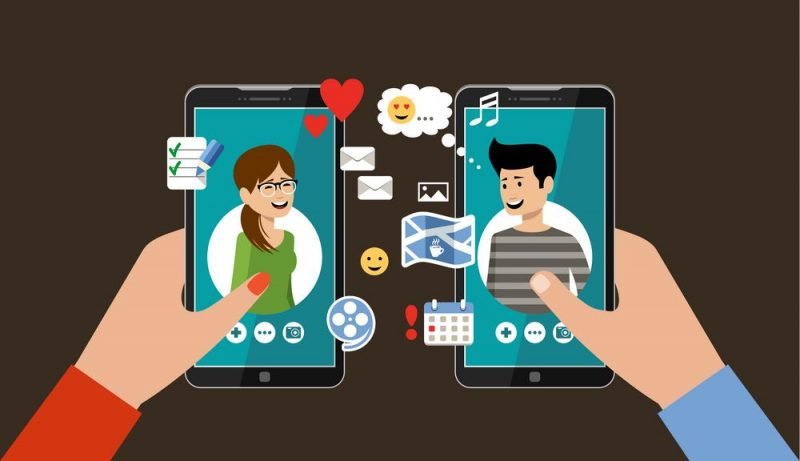There was a time where it was uncommon, and even a bit weird, to say, “I met a great guy/girl online!” In some cases, meeting someone online even seemed a bit taboo. To stir the pot even more, at some point someone figured out how to create a dating app for smartphones – and finding love moved from online to the palm of our hands.
Today, online and mobile dating is a natural part of our culture. According to The Knot, online dating is now the most common way of meeting for engaged couples. But let’s face it, there are almost as many dating apps on the market as there are daters; and out of all of them, only a handful are able to secure more than a couple of thousand users.
If you’re looking to launch a startup in the mobile dating sector, I’ll be honest… you’re facing a tough challenge. There’s a very thin line between great dating apps and cheesy dating apps, and a disappointing ratio of dating apps that succeed to those that don’t. The good news is if you know how to create a dating app startup the right way – you can drastically minimize your risk of failure. There will be a next greatest dating app, will you be the one to create it?
In this article, we’ll explain what you need to know about creating and developing a dating app, and specifically, we’re going to explore exactly how to create a dating app that doesn’t suck.
Why Dating Apps Suck
First, let’s clear something up – not ALL dating apps suck, just most of them. Also, not all of them suck for the same reason. There are some apps out there that have millions and millions of users, like Tinder and Bumble. Some others serve super niche markets and may have a smaller but still significant user base; like Bristlr, the dating app for beard lovers, which has around 150,000 users. If there are millions of mobile daters out there, why do so many dating app startups fail? Simple… because they suck, and here’s three reasons why:
- User Goals: Most dating app entrepreneurs don’t actually know what their intended user really wants – and if you don’t know what they want, you’ll never know how to build a dating app that meets their need. What does it mean to date? Does this mean someone is looking to date a bunch of different people and enjoy their single life – or that they are dating to hopefully find a special someone? Dating apps are easily accessible and often used by a wide variety of daters with conflicting goals. Some users may be looking for a whole life companion, while others may be looking for a one time hookup. Popular online sites like Match were able to attract individuals with similar goals by charging higher fees and making the matching process extremely thorough. For someone searching for long-term potential, swiping on Tinder may lead to many many low quality dates before a real match is ever found. According to Psychology Today, only 8.9% of Tinder’s users actually use the app due to a desire for a relationship – while the majority of people have signed up solely off the hype.
- Copycat Innovation: While there are probably hundreds of dating apps on the market, many of them seem almost identical in technology and functionality. Or, they use the same technology but serve a niche market instead. Tinder introduced the “swipe dating” model for instance, and since then, a hundred other swipe dating apps have hit the market. Maybe one is a swipe dating app for farmers, or a swipe dating app for people who love country music – but innovation in the mobile dating industry has been relatively flat over the last several years. Many brands have figured out how to create a dating app, they just haven’t figured how to create one that actually moves the industry forward.
- No Growth Plan: Some dating apps seem promising at launch, gaining some hype in the early days only to quickly fall completely off the map. Successful dating apps require a deep level of traction and a strong momentum. Even the best dating app concept won’t succeed if they are unable to drive enough people to the app to make it worthwhile. Dating app consumers aren’t extremely loyal – if there isn’t a large pool of potential daters available in their specific areas, they’ll quickly move on to the next dating app. Likewise, if they sign in every day and there are never any new potential matches, they will move on to an app with a deeper local penetration. Knowing how to build a dating app means more than just creating a great idea, you also need to implement an effective growth strategy that builds the necessary momentum.
Coming Up With A Dating App Concept
The point of any dating app should be to make dating easier, more convenient, more effective, or at least, more fun. Nobody needs just another dating app, people need the right dating app that will actually serve their needs. When developing or evaluating your dating app concept, consider the following questions:
- Who Are You Helping? Knowing your customer is everything. Not every dater is the same. A 20-year-old millennial dater may be looking for something totally different than 50-year-old recently divorced dater. If you want to know how to create a dating app that wins – first decide who you will serve and identify the pain points that they have with dating. Also, find out why consumers in that segment have trouble meeting their dating goals with current solutions. The more you know about your user, the better you will be able to serve them.
- How Are You Helping Them? Once you know your consumer’s goals, it will become easier to figure out how to help them. Identify what your customer truly seeks and design a solution that helps them meet that particular goal. No one wants another app that “helps singles find dates” — but millions might want to use “an app that helps millennials find long term relationships with people of similar interests” or “an app that helps divorcees meet one another to form new relationships” or “an app that helps single parents have fun with other adults”. It’s not necessarily always about being niche, but it is always about providing a real solution to a real problem.
- How Are You Different? Consumers aren’t typically loyal to just one dating app, in the same way that most people have profiles on multiple social media platforms. If your concept isn’t different enough, why would users stay on your app instead of using the three other dating apps they have installed on their smartphone? Knowing how to start a dating app requires out-of-the box thinking – be creative, be innovative; do something new. When everyone else is releasing swipe-based dating apps, figure out how to create a strong video-based dating app concept. When everyone else is focused on interest-based matching, consider perfecting the “mystery match” angle. I can’t say exactly what will work for you, but I can tell you what definitely will not work for you – reusing the same technology and concepts that dating consumers have seen a million times already.
Proving The Demand
It is a fact that people want to date, and that people are open to using technology to help them. It is an only assumption, however, that your concept is the right one to help them meet their dating goals. Prior to your dating app development (before even touching the first line of code, it is important to prove that singles would even be interested in using the dating app concept that you have developed.
Instead of jumping the gun and immediately hiring your local dating app developers; start by blueprinting your idea to visualize how it will look, then have the app designed. Develop a low-function (or no-function) demo or prototype, or in some cases, even a well-put-together app video will do.
Create a focus group of individuals within your specific demographic. If your dating app specifically targets 20-35-year-old musicians who are looking to date other musicians – get ten single musicians together to form your focus group. Show them the demo, ask them questions about their thoughts and encourage them to give feedback; open up the floor and allow them to ask you questions about your concept. By going through this focus group process, you will realize one of three things about your dating app concept:
- It’s awesome just like you thought it would be. Everyone loves it, says they would use it and tells you that it’s exactly what they were looking for. You’re ready to move to development.
- It’s sort’ve cool – most people like it, but many people also had suggestions about what could make it better. With a few tweaks and a slight pivot, the app concept can be strengthened and made more effective.
- Everyone hates it. The majority of people remark that it wouldn’t really help them, or that it wouldn’t help them better than other solutions. Either way, the cost of making a dating app is extremely high – and you just saved tens of thousands on wasted development. Back to the dating app drawing board you go!
If you want to know how to create a dating app that doesn’t suck, the first tip is – make sure it doesn’t suck before you develop it. Focus groups give you the opportunity to test the awesomeness or suckiness of your concept before undertaking the expense and effort of developing it into a functional application.
Creating A Buzz
Dating apps often fail because they can’t generate enough traffic to sustain the demand of their users. Imagine these scenarios:
- You are a startup in Chicago and you just launched your dating app. A single man in Detroit downloads the application and finds that there are no matches in his area – and actually, only a few total users in his area. He deletes the app.
- You are a startup in Miami. A single woman in Miami downloads the application and views the limited pool of potential daters. She logs out. She signs in two weeks later and the pool still only includes the same people that were there weeks before. She deletes the app.
Downloads mean very little if there is no retention; and if there is no momentumous traction to your dating app, users likely won’t stick around for long. The success of your dating app will lean heavily on how you launch it and how you market it.
Launch Regionally
There’s really no point in immediately launching your dating app to a huge market. Consider the first scenario – if there are very few users in a region, there is very little value for a consumer within that region. For dating apps to work, there must be a dense pool of daters within the region that a consumer will want to date.
Start by launching in one city. Penetrate that city as deeply as possible so that daters in that city can access a large pool of potential matches. Once successful, scale into another city (or several cities), and then throughout a whole region. As you create more buzz, the user adoption process will become much easier each time you scale.
Develop A Strong Marketing Strategy
Knowing how to make a dating app means very little if you aren’t able to get it in front of your audience. Dating app startups have less options when it comes to marketing online. Some platforms, like Facebook, don’t allow dating apps to purchase ads, which limits the opportunity for these apps to reach social media audiences. Marketing is critical to building traction for your dating app. Consider scenario 2 – if new daters aren’t constantly being added to the network, users find no reason to revisit the application.
Be creative in your strategy. Some dating apps start at universities, advertising their apps on site (Tinder partnered with sororities). By launching regionally, you can even take advantage of traditional regional marketing channels such as radio and television. For more ideas, check out our article on how to make an app go viral.
Finding The Right Developers
Lastly, it’s important to have the right dating app developers on your team. Your developers shouldn’t only understand apps – but they should specifically understand the functions of dating apps and be highly experienced in building technology with a lean process.
At ThinkLions, we know exactly how to start a dating app that doesn’t suck. We have worked with several dating app startups – helping them raise hundreds of thousands in investor seed funding to bring their app ideas to life. Ready to create the next major dating app innovation? Contact us today and see how we can help you reach your app startup goals.










